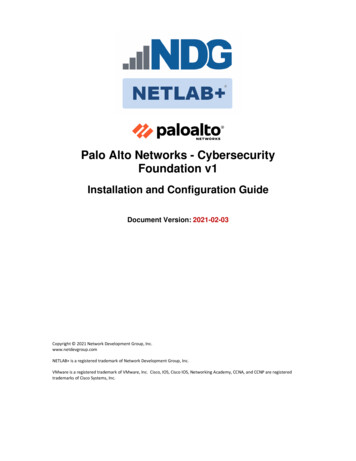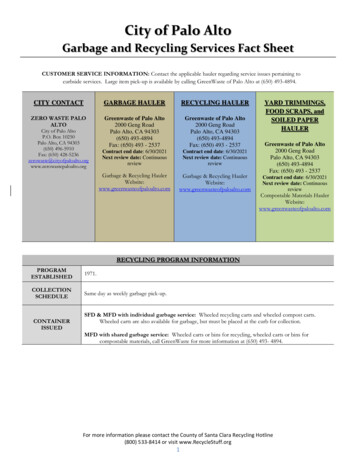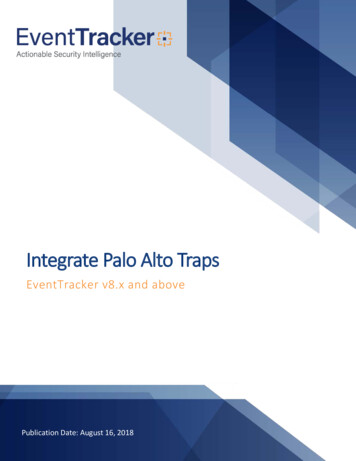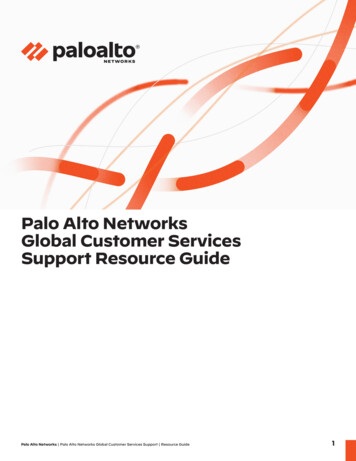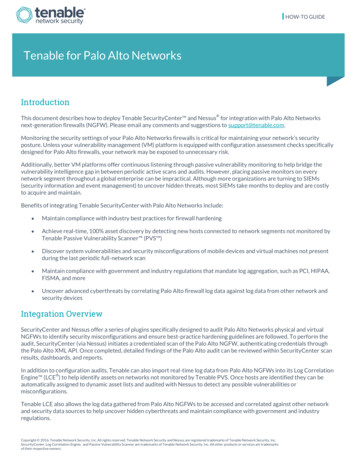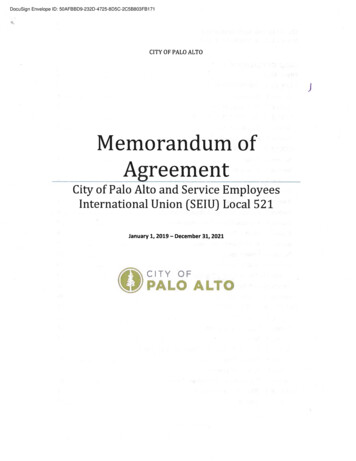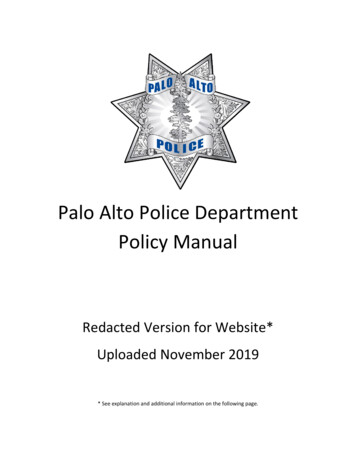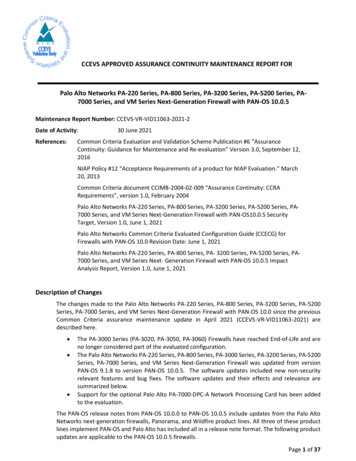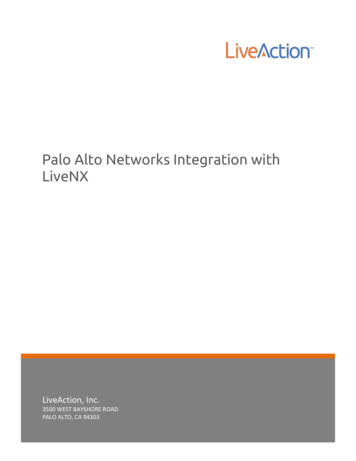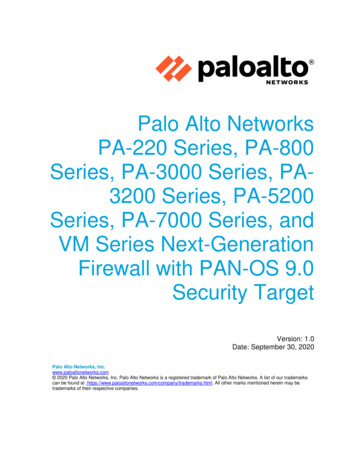
Transcription
Palo Alto NetworksPA-220 Series, PA-800Series, PA-3000 Series, PA3200 Series, PA-5200Series, PA-7000 Series, andVM Series Next-GenerationFirewall with PAN-OS 9.0Security TargetVersion: 1.0Date: September 30, 2020Palo Alto Networks, Inc.www.paloaltonetworks.com 2020 Palo Alto Networks, Inc. Palo Alto Networks is a registered trademark of Palo Alto Networks. A list of our trademarkscan be found at s.html. All other marks mentioned herein may betrademarks of their respective companies.
PAN OS 9.0 Security TargetPalo Alto NetworksTable of Contents1. SECURITY TARGET INTRODUCTION .11.1SECURITY TARGET, TOE AND CC IDENTIFICATION.11.2CONFORMANCE CLAIMS . 31.3CONVENTIONS .51.3.1Terminology .51.3.22.Acronyms.5PRODUCT DESCRIPTION . 72.1TOE OVERVIEW .82.2TOE ARCHITECTURE . 102.2.1Physical Boundaries . 112.2.22.32.4Logical Boundaries . 20TOE DOCUMENTATION . 21EXCLUDED FUNCTIONALITY . 223.SECURITY PROBLEM DEFINITION . 234.SECURITY OBJECTIVES . 244.15.SECURITY OBJECTIVES FOR THE OPERATIONAL ENVIRONMENT. 24IT SECURITY REQUIREMENTS . 265.1EXTENDED REQUIREMENTS . 265.2TOE SECURITY FUNCTIONAL REQUIREMENTS . 265.2.1Security Audit (FAU) . 285.2.2Cryptographic Support (FCS) . 315.2.3User Data Protection (FDP) . 425.2.4Identification and Authentication (FIA) . 425.2.5Security Management (FMT). 445.2.6Protection of the TSF (FPT) . 465.2.7TOE Access (FTA) . 475.2.8Trusted Path/Channels (FTP) . 475.2.9Stateful Traffic Filtering (FFW) . 495.2.10Packet Filtering (FPF). 535.3 TOE SECURITY ASSURANCE REQUIREMENTS . 546.TOE SUMMARY SPECIFICATION. 556.16.26.36.46.56.66.76.86.96.107.SECURITY AUDIT. 55CRYPTOGRAPHIC SUPPORT . 56USER DATA PROTECTION. 65IDENTIFICATION AND AUTHENTICATION . 66SECURITY MANAGEMENT . 69PROTECTION OF THE TSF . 70TOE ACCESS . 73TRUSTED PATH/CHANNELS . 74STATEFUL TRAFFIC FILTERING. 75PACKET FILTERING . 81PROTECTION PROFILE CLAIMS . 82Page ii of iv
PAN OS 9.0 Security Target8.Palo Alto NetworksRATIONALE . 83Page iii of iv
PAN OS 9.0 Security TargetPalo Alto NetworksLIST OF FIGURESFigure 1: TOE Architecture . 10LIST OF TABLESTable 1 TOE Platforms . 14Table 2 Excluded Features . 22Table 3 TOE Security Functional Components . 26Table 4 Auditable Events . 28Table 5 Assurance Components. 54Table 6 Cryptographic Functions . 56Table 7 FIPS 186-4 Conformance . 58Table 8 Private Keys and CSPs . 59Page iv of iv
PAN OS 9.0 Security TargetPalo Alto Networks1. Security Target IntroductionThis section identifies the Security Target (ST) and Target of Evaluation (TOE) identification, STconventions, ST conformance claims, and the ST organization. The TOE is the next-generation firewallrunning PAN-OS v9.0.9-h1 provided by Palo Alto Networks Inc.The next-generation firewall includes the PA-220, PA-220R, PA-820, PA-850, PA-3020, PA-3050, PA3060, PA-3220, PA-3250, PA-3260, PA-5220, PA-5250, PA-5260, PA-5280, PA-7050, and PA-7080appliances and the virtual appliances in the VM-Series VM-50, VM-100, VM-200, VM-300, VM-500, VM700, VM-1000-HV which are used to manage enterprise network traffic flows using function specificprocessing for networking, security, and management. The next-generation firewalls identify whichapplications are flowing across the network, irrespective of port, protocol, or location. The User IdentificationAgent (UIA) installed on a PC in the operational environment communicates with the domain controller toretrieve user-specific information. It allows the next-generation firewall to automatically collect userinformation and include it in policies and enforcement.The focus of this evaluation is on the TOE functionality supporting the claims in the collaborative ProtectionProfile for Network Devices [NDcPP], PP-Module for Stateful Traffic Filter Firewalls [FW-Module], and PPModule for Virtual Private Network (VPN) Gateways [VPNGW-Module] as amended by CSfC Selections forVPN Gateways [CSfC]. The CSfC Selections for VPN Gateways are specified in the following tions/vpn-gateways.pdfThe only capabilities covered by the evaluation are those specified in the aforementioned ProtectionProfiles, all other capabilities are not covered in the evaluation. The security functionality specified in[NDcPP], the [FW-Module], and the [VPNGW-Module] includes protection of communications between TOEcomponents and trusted IT entities, identification and authentication of administrators, auditing of securityrelevant events, ability to verify the source and integrity of updates to the TOE, the implementation offirewall-related security features, the termination of IPsec VPN tunnels, and specifies CAVP-validatedcryptographic mechanisms.The Security Target contains the following additional sections: Product Description (Section 2) Security Problem Definition (Section 3) Security Objectives (Section 4) IT Security Requirements (Section 5) TOE Summary Specification (Section 6) Protection Profile Claims (Section 7) Rationale (Section 8).1.1 Security Target, TOE and CC IdentificationST Title – Palo Alto Networks PA-220 Series, PA-800 Series, PA-3000 Series, PA-3200 Series, PA-5200Series, PA-7000 Series, and VM Series Next-Generation Firewall with PAN-OS 9.0 Security TargetST Version – Version 1.0ST Date – September 30, 2020TOE Identification – Palo Alto Networks PA-220 Series, PA-800 Series, PA-3000 Series, PA-3200 Series,PA-5200 Series, PA-7000 Series, and VM Series, Next-Generation Firewall with PAN-OS v9.0. The specificFirewall appliance models include:1. PA-220 SeriesPage 1 of 83
PAN OS 9.0 Security TargetPalo Alto Networksa. PA-220b. PA-220R2. PA-800 Seriesa. PA-820b. PA-8503. PA-3000 Seriesa. PA-3020b. PA-3050c.PA-30604. PA-3200 Seriesa. PA-3220b. PA-3250c.PA-32605. PA-5200 Seriesa. PA-5220b. PA-5250c.PA-5260d. PA-52806. PA-7000 Series1a. PA-7050b. PA-70807. VM-Seriesa. VM-50b. VM-100c.VM-200d. VM-300e. VM-500f.VM-700g. VM-1000-HVThe Palo Alto VM-Series is supported on the following hypervisors: VMwareo VMware ESXi with vSphere 5.5, 6.0, 6.5, or 6.7 Linux KVMo Ubuntu: 14.04 LTS QEMU-KVM 2.0.0 and libvirt 1.2.2)o Ubuntu: 16.04 LTS (QEMU-KVM 2.5 0; libvirt 1.3.1; Open vSwitch: 2.5.0)o CentOS/RedHat Enterprise Linux: 7 (QEMU-KVM 1.5.3 and libvirt 2.0.0)1Palo Alto Networks PA-7000 Series firewalls support five different Network Processing Cards (NPC): PAN-PA7000-20G-NPC, PAN-PA-7000-20GQ-NPC, PAN-PA-7000-20GXM-NPC, PAN-PA-7000-20GQXM-NPC, andPAN-PA-7000-100G-NPC.Page 2 of 83
PAN OS 9.0 Security Target Palo Alto Networkso CentOS: 7 (QEMU-KVM 1.5.3 and libvirt 3.9.0)Microsoft Hyper-V Server 2012 R2 ---- The VM-Series firewall can be deployed on a serverrunning Microsoft Hyper-V. Hyper-V is packaged as a standalone hypervisor, called Hyper-VServer 2012 R2, or as an add-on/role for Windows Server 2012 R2.The VM-Series must be the only guest running in the virtualized environment. Evaluation testing includedthe following:VMware ESXi 6.5: Dell PowerEdge R730 Processor: Intel XEON CPU E5-2640 v4 (Broadwell microarchitecture)with Broadcom 5720 NICMemory: 64 GB ECC DDR4 2133Microsoft Hyper-V Server 2012 R2: Dell PowerEdge R730 Processor: Intel XEON CPU E5-2640 v4 (Broadwell microarchitecture)with Broadcom 5720 NICMemory: 64 GB ECC DDR4 2133Linux KVM CentOS 7.5: Dell PowerEdge R730 Processor: Intel XEON CPU E5-2640 v4 (Broadwell microarchitecture)with Broadcom 5720 NICMemory: 64 GB ECC DDR4 2133Evaluation testing included the following hardware and processors: PA-3260: Cavium Octeon CN7360 MIPS64 (DP) / Intel Pentium D1517 (MP) PA-7080: Cavium Octeon CN6880 MIPS64 (DP) / Intel Core i7-2715 (MP)TOE Developer – Palo Alto Networks, Inc.Evaluation Sponsor – Palo Alto Networks, Inc.CC Identification – Common Criteria for Information Technology Security Evaluation, Version 3.1, Revision5, April 20171.2 Conformance ClaimsThis ST and the TOE it describes are conformant to the following CC specifications:PP-Configuration for Network Devices, Stateful Traffic Filter Firewalls, and Virtual Private Network (VPN)Gateways, Version 1.0, March 6, 2020 [CFG NDcPP-FW-VPNGW V1.0] consisting of the followingcomponents:·collaborative Protection Profile for Network Devices, Version 2.1, 24 September 2018 [NDcPP]·PP-Module for Stateful Traffic Filter Firewalls, Version 1.3, 27 September 2019 [FW-Module]·PP-Module for Virtual Private Network (VPN) Gateways, Version 1.0, 17 September 2019[VPNGW-Module]The following NIAP Technical Decisions2 apply to this [NDcPP] and have been accounted for in the STdevelopment and the conduct of the evaluation:2 0484 – NIT Technical Decision for Interactive sessions in FTA SSL EXT.1 & FTA SSL.3 0483 – NIT Technical Decision for Applicability of FPT APW EXT.1The following TDs are not applicable: 453, 451, 447, and 411.Page 3 of 83
PAN OS 9.0 Security TargetPalo Alto Networks 0482 – NIT Technical Decision for Identification of usage of cryptographic schemes 0481 – NIT Technical Decision for FCS (D)TLSC EXT.X.2 IP addresses in referenceidentifiers 0480 – NIT Technical Decision for Granularity of audit events 0478 – NIT Technical Decision for Application Notes for FIA X509 EXT.1 0477 – NIT Technical Decision for Clarifying FPT TUD EXT.1 Trusted Update 0475 – NIT Technical Decision for Separate traffic consideration for SSH rekey 0450 – NIT Technical Decision for RSA-based ciphers and the Server Key Exchange message 0425 – NIT Technical Decision for Cut-and-paste Error for Guidance AA 0424 – NIT Technical Decision for NDcPP v2.1 Clarification - FCS SSHC/S EXT1.5 0423 – NIT Technical Decision for Clarification about application of RfI#201726rev2 0412 – NIT Technical Decision for FCS SSHS EXT.1.5 SFR and AA discrepancy 0410 – NIT technical decision for Redundant assurance activities associated with FAU GEN.1 0409 – NIT decision for Applicability of FIA AFL.1 to key-based SSH authentication 0408 – NIT Technical Decision for local vs. remote administrator accounts 0407 – NIT Technical Decision for handling Certification of Cloud Deployments 0402 – NIT Technical Decision for RSA-based FCS CKM.2 Selection 0401 – NIT Technical Decision for Reliance on external servers to meet SFRs 0400 – NIT Technical Decision for FCS CKM.2 and elliptic curve-based key establishment 0399 – NIT Technical Decision for Manual installation of CRL (FIA X509 EXT.2) 0398 – NIT Technical Decision for FCS SSH*EXT.1.1 RFCs for AES-CTR 0397 – NIT Technical Decision for Fixing AES-CTR Mode Tests 0396 – NIT Technical Decision for FCS TLSC EXT.1.1, Test 2 0395 – NIT Technical Decision for Different Handling of TLS1.1 and TLS1.2The following NIAP Technical Decisions apply to [FW-Module] and/or [VPNGW-Module] and have beenaccounted for in the ST development and the conduct of the evaluation: 0520 – VPN Gateway SFR Rationale 0511 – VPN GW Conformance Claim to allow for a PP-ModuleCommon Criteria for Information Technology Security Evaluation Part 2: Security functional components,Version 3.1, Revision 5, April 2017. Part 2 ExtendedCommon Criteria for Information Technology Security Evaluation Part 3: Security assurance components,Version 3.1 Revision 5, April 2017. Part 3 Conformant.Page 4 of 83
PAN OS 9.0 Security TargetPalo Alto Networks1.3 ConventionsThe following conventions have been applied in this document: Security Functional Requirements – Part 2 of the CC defines the approved set of operations thatmay be applied to functional requirements: iteration, assignment, selection, and refinement. All operations performed in this ST are identified according to conventions described in [NDcPP],[FW-Module], and [VPNGW-Module]. The ST author does not change operations that have been completed by the PP authors nor undothe formatting. For example, if the text is italicized, bolded, or underlined by the PP author, the STauthor will not undo it. In this way operations have been identified. Selection/Assignment operations completed by the PP author remain as described in the [NDcPP][FW-Module], and [VPNGW-Module]. Selection/Assignment operations completed by the ST author was bolded to show that it wascompleted by the ST author and not taken as-is from the PP. Iteration operations completed by the ST author are identified with (1), (2), and (next number) withdescriptive text following the name (e.g. FCS HTTPS EXT.1(1) HTTPS Protocol (TLS Server)). Refinement operations completed by the ST author are identified in BOLD text.1.3.1 TerminologyThe following terms and abbreviations are used in this ST:AuthenticationProfileDefine the authentication service that validates the login credentials of administratorswhen they access TOE.Role-BasedAccessControlDefine the privileges and responsibilities of administrative users (administrators).Every administrator must have a user account that specifies a role and authenticationmethod.SecurityPolicyProvides the firewall rule sets that specify whether to block or allow networkconnections.SecurityProfileA security profile specifies protection rules to apply when processing network traffic.The profiles supported by the TOE include the IPsec crypto Security profile, IKENetwork profile, and Vulnerability profile.Security ZoneA grouping of TOE interfaces. Each TOE interface must be assigned to a zone beforeit can process traffic.Virtual SystemVirtual systems are separate, logical firewall instances within a single physical PaloAlto Networks firewall. Virtual systems allow the TOE administrator to customizeadministration, networking, and security policies for network traffic belonging tospecific user groupings (such as departments or customers).1.3.2 AcronymsAESAPICBCCCCEMCMCLIAdvanced Encryption StandardApplication Programming InterfaceCipher-Block ChainingCommon CriteriaCommon Evaluation MethodologyConfiguration ManagementCommand Line InterfacePage 5 of 83
PAN OS 9.0 Security SHSSLSTTLSTOETSFUDPURLVLANVMVPNVPNGWPalo Alto NetworksDiffie-HellmanDemilitarized ZoneDeterministic Random Bit GeneratorData PlaneElectrically Erasable Programmable Read-Only MemoryFederal Information Processing StandardFunctional SpecificationFile Transfer ProtocolGalois/Counter ModeGraphical User InterfaceHashed Message Authentication CodeHypertext Transfer Protocol SecureInternet Control Message ProtocolInternet Key ExchangeInternet ProtocolInternet Protocol version 4Internet Protocol version 6Internet Protocol SecurityManagement PlaneNetwork Address TranslationNational Institute of Standards and TechnologyProtection ProfileRepresentational State TransferRivest, Shamir and Adleman (algorithm for public-keycryptography)Security AssociationSecurity Assurance RequirementSecurity Functional RequirementSecure Hash AlgorithmSecure ShellSecure Socket LayerSecurity TargetTransport Layer SecurityTarget of EvaluationTOE Security FunctionsUser Datagram ProtocolUniform Resource LocatorVirtual Local Area NetworkVirtual MachineVirtual Private NetworkVirtual Private Network GatewayPage 6 of 83
PAN OS 9.0 Security TargetPalo Alto Networks2. Product DescriptionPalo Alto Networks provides a wide suite of enterprise-level next-generation firewalls, with a diverse rangeof security features for the enterprise network.The Palo Alto next-generation firewalls are network firewall appliances and virtual appliances on specifiedhardware used to manage enterprise network traffic flow using function-specific processing for networking,security, and management. The next-generation firewalls let the administrator specify security policiesbased on an accurate identification of each application seeking access to the protected network. The nextgeneration firewall uses packet inspection and a library of applications to distinguish between applicationsthat have the same protocol and port, and to identify potentially malicious applications that use nonstandard ports. The next-generation firewall also supports the establishment of Virtual Private Network(VPN) connections to other next-generation firewalls or third party security devices.The products below are considered trusted IT products in the operational environment and only the securecommunication (FPT ITC.1) between the firewalls and the products are claimed and validated in thisevaluation. The product descriptions below are provided for completeness only. Panorama network security management appliance enables control of a centralized managementof network of Palo Alto firewalls from one central location. An administrator may view all of thefirewall traffic, manage all aspects of device configuration, push global policies, and generatereports on traffic patterns or security incidents — all from a single console. The WildFire appliance provides an on-premises WildFire private cloud, enabling the analysis ofsuspicious files in a sandbox environment without requiring the firewall to sends files out ofnetwork. The WildFire appliance can be configured to host a WildFire private cloud where thefirewall is configured to submit samples to the local WildFire appliance for analysis. The WildFireappliance sandboxes all files locally and analyzes them for malicious behaviors using the sameengine the WildFire public cloud uses. Within minutes, the private cloud returns analysis results tothe firewall WildFire Submissions logs. The WildFire appliance can be configured to locallygenerate antivirus and DNS signatures for discovered malware, and to assign a URL category tomalicious links. Connected firewalls can be enabled to retrieve the latest signatures and URLcategories every five minutes. Malware can be submitted to the WildFire public cloud. The WildFirepublic cloud re-analyzes the sample and generates a signature to detect the malware—thissignature can be made available within minutes to protect global users. Locally-generatedmalware reports (without sending the raw sample content) can be submitted to the WildFire publiccloud, to contribute to malware statistics and threat intelligence. Up to 100 Palo Alto Networksfirewalls, each with a valid WildFire subscription, can be configured to forward samples to a singleWildFire appliance. Beyond the WildFire firewall subscriptions, no additional WildFire subscriptionis required to enable a WildFire private cloud deployment. GlobalProtect safeguards the mobile workforce by inspecting all traffic using the organization’snext-generation firewalls that are deployed as internet gateways, whether at the perimeter, in theDMZ, or in the cloud. Laptops, smartphones and tablets with the GlobalProtect app automaticallyestablish a secure TLS/IPsec VPN connection to the next-generation firewall with the bestperformance for a given location, thus providing the organization with full visibility of all networktraffic, for applications, and across all ports and protocols. By eliminating the blind spots in mobileworkforce traffic, the organization maintains a consistent view into applications.The User Identification Agent (UIA) automatically collects user-specific information, and providesmapping information between IP addresses and network users, and provides these information tothe TOE which then uses mappings in its security policy enforcement. The user ID can be anattribute specified in the TOE security policies upon which they are enforced. Page 7 of 83
PAN OS 9.0 Security TargetPalo Alto Networks2.1 TOE OverviewThe Target of Evaluation (TOE) is comprised of one instance of the Palo Alto Networks next-generationfirewall that includes the Palo Alto Networks PA-220, PA-220R, PA-820, PA-850, PA-3020, PA-3050, PA3060, PA-3220, PA-3250, PA-3260, PA-5220, PA-5250, PA-5260, PA-5280, PA-7050, and PA-7080appliances and the virtual appliances in the VM-Series VM-50, VM-100, VM-200, VM-300, VM-500, VM700, VM-1000-HV with PAN-OS v9.0.9-h1. The next-generation firewall provides policy-based applicationvisibility and control to protect traffic flowing through the enterprise network.The next-generation firewalls are network firewall appliances and virtual appliances on specified hardwareused to manage enterprise network traffic flow using function-specific processing for networking, security,and management. The next-generation firewalls let the administrator specify security policies based on anaccurate identification of each application seeking access to the protected network. The next-generationfirewall uses packet inspection and a library of applications to distinguish between applications that havethe same protocol and port, and to identify potentially malicious applications that use non-standard ports.The next-generation firewall also supports the establishment of Virtual Private Network connections to othernext-generation firewalls or third-party security devices.A next-generation firewall is typically installed between an edge router or other device facing the Internetand a switch or router connecting to the internal network. The Ethernet interfaces on the firewall can beconfigured to support various networking environments, including: Layer 2 switching and VLANenvironments; Layer 3 routing environments; transparent in-line deployments; and combinations of thethree. The scope of the evaluation does not cover Layer 2 switching, VLAN, and transparent in-linedeployments.The next-generation firewalls provide granular control over the traffic allowed to access the protectednetwork. They allow an administrator to define security policies for specific applications, rather than relyon a single policy for connections to a given port number. For each identified application, the administratorcan specify a security policy to block or allow traffic based on the source and destination zones, source anddestination addresses, or application services. The next-generation firewalls also support the followingtypes of policy: Application-based policies (e.g., FTP) User Identification Agent (UIA) - the TOE uses user-specific information provided by UIA in theoperational environment for security policy enforcement. The UIA automatically collects userspecific information, and provides mapping information between IP addresses and network users,and provides these information to the TOE which then uses mappings in its security policyenforcement. The user ID can be an attribute specified in the TOE security policies upon whichthey are enforced. The UIA works with both IPv4 addresses and IPv6 addresses.Security policies can include specification of one or more security profiles, which provide additionalprotection and control. Security profiles are configured and applied to firewall policy. Each security policycan specify one or more of the following security profiles: Vulnerability Protection profiles DoS Protection profiles IKE Crypto Security profiles IPsec Crypto Security profilesThe next-generation firewall products provide the following features: Application-based policy enforcement — the product uses a traffic classification technology namedApp-ID to classify traffic by application content irrespective of port or protocol. Protocol and portcan be used in conjunction with application identification to control what ports an application isallowed to run on. High risk applications can be blocked, as well as high-risk behavior such as filesharing or FTP.Page 8 of 83
PAN OS 9.0 Security TargetPalo Alto Networks Threat prevention — the firewall includes threat prevention capabilities (i.e., Vulnerability Protectionprofile) that can protect the network from viruses, worms, spyware, and other malicious traffic. Inthe context of this evaluation, this feature is used to block malicious malformed, fragmentedpackets. The protection from viruses, worm, and spyware using signatures are out of scope (i.e.,not evaluated). DoS Protection – the firewall is designed to protect against flooding attack within th
Palo Alto Networks PA-220 Series, PA-800 Series, PA-3000 Series, PA-3200 Series, PA-5200 . (VPN) Gateways [VPNGW-Module] as amended by CSfC Selections for . NIT Technical Decision for Interactive sessions in FTA_SSL_EXT.1 & FTA_SSL.3 0483 - NIT Technical Decision for Applicability of FPT_APW_EXT.1 .
